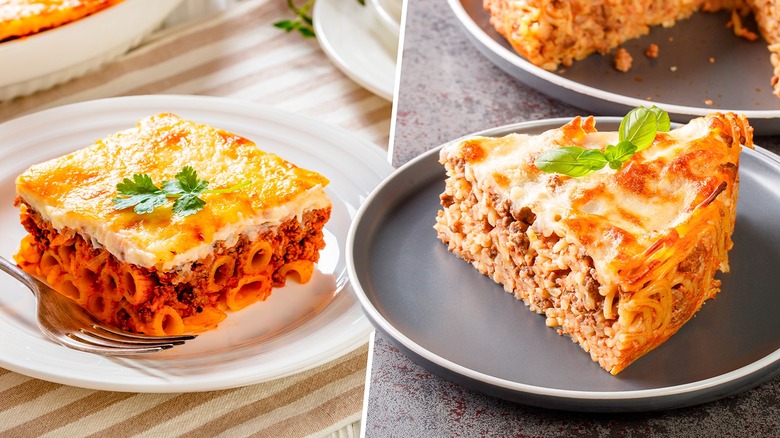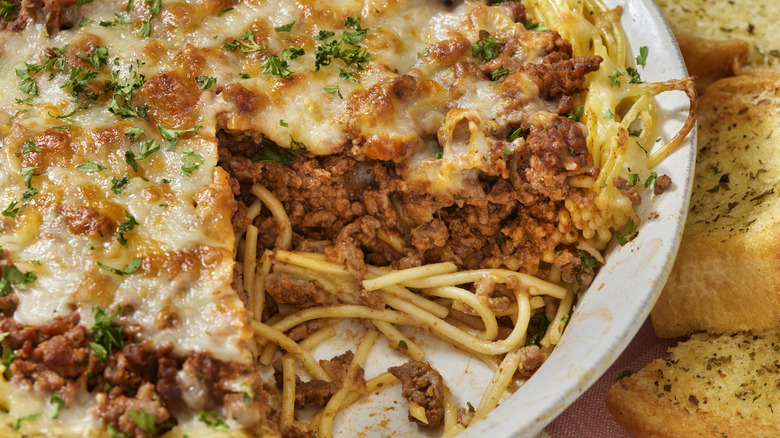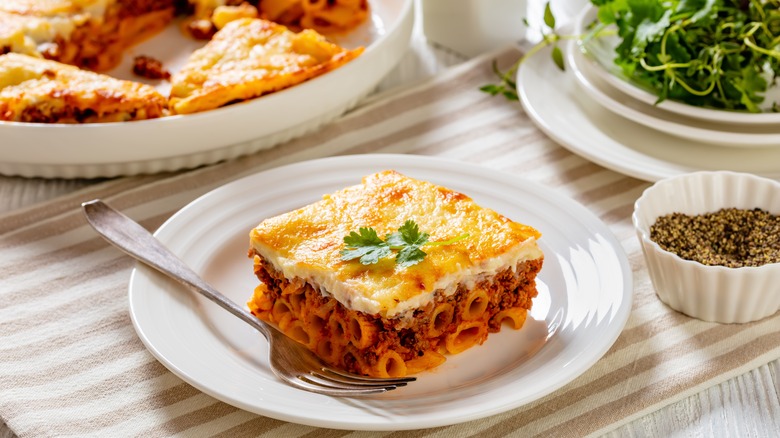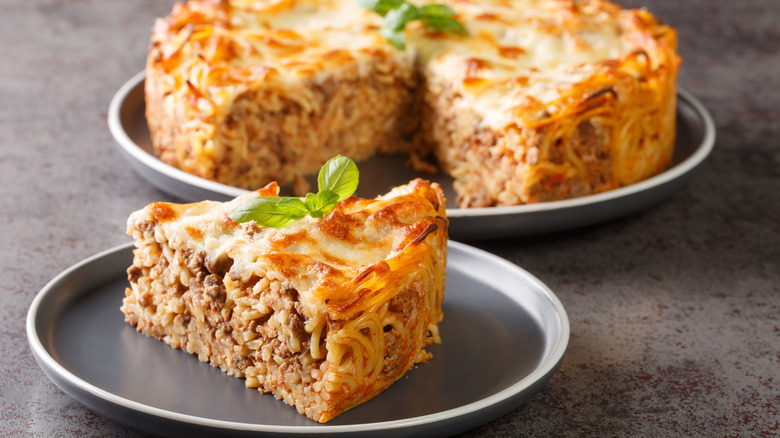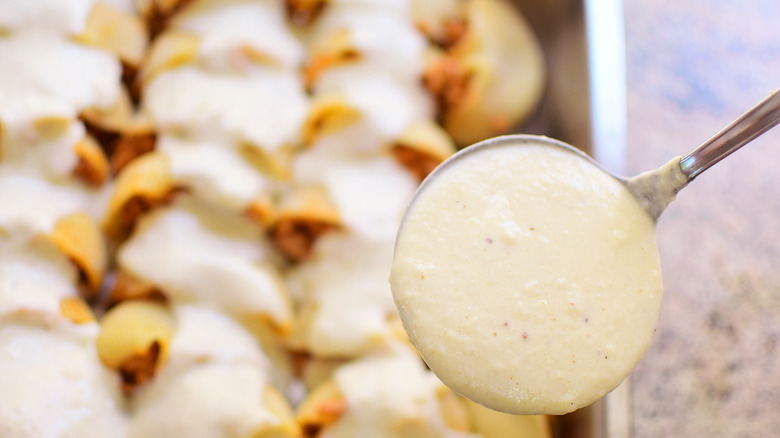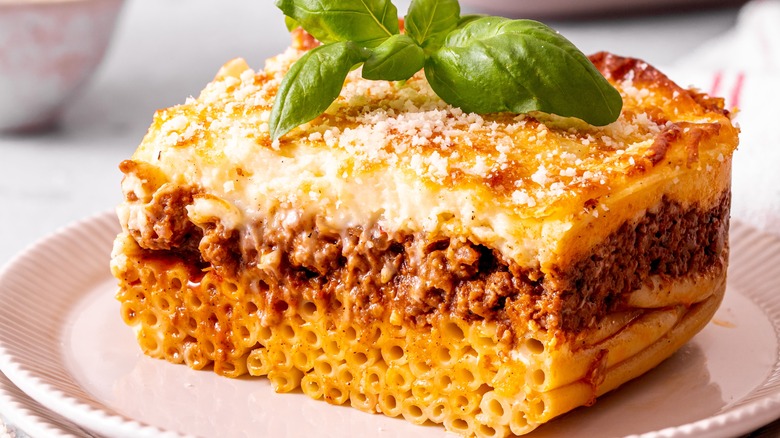Spaghetti Pie Vs Baked Greek Pasta: What's The Difference?
In the world of baked pasta, there are seemingly endless versions of the deliciously crispy dishes. Among the variants, two beloved classics, spaghetti pie and pastitsio, stand out for their deceptive similarity. While both dishes share the common thread of being baked pasta creations, each offers its own unique twist on flavor and presentation. Spaghetti pie, a cherished favorite in American households, combines cooked spaghetti with eggs, cheese, and sometimes meat or vegetables, all bound together in a pie-like form and baked until golden and crispy. On the other hand, pastitsio, a staple of Greek cuisine, layers cooked pasta with a rich, spiced meat sauce, topped with a creamy béchamel sauce and baked until bubbly.
While both dishes boast hearty and comforting flavors, they differ in their ingredients and preparation methods. Pastitsio leans towards Mediterranean flavors and spices, while, spaghetti pie embraces a more versatile and customizable approach. Whether you're craving the comforting familiarity of spaghetti pie or the creaminess of pastitsio, both dishes promise to satisfy your cravings for baked pasta perfection. Let's take a closer look at how they differ.
What is spaghetti pie?
Spaghetti pie is a surprising fusion of pasta and pie that entices the taste buds with its hearty and comforting flavors. This ingenious creation transforms ordinary spaghetti into a savory pie-like dish that's both easy to make and incredibly satisfying to eat. Key ingredients for an easy-to-make version typically include cooked spaghetti, eggs, cheese (such as mozzarella or Parmesan), and a savory sauce (like marinara or meat sauce).
While the origins of spaghetti pie are somewhat elusive, it's believed to have emerged in mid-20th-century America as a clever way to repurpose leftover spaghetti into a new and exciting dish. Over the years, spaghetti pie has evolved into a beloved staple, cherished for its versatility, simplicity, and delicious flavors. Whether enjoyed as a cozy weeknight dinner or a crowd-pleasing potluck dish, spaghetti pie continues to capture the hearts and appetites of pasta lovers everywhere, proving that sometimes the most humble ingredients can create extraordinary culinary delights.
What is pastitsio?
Enter the world of Mediterranean flavors with pastitsio, the lasagna cousin you should know and the crown jewel of Greek comfort food. This traditional baked pasta dish is, at its heart, a harmonious marriage of tender pasta, flavorful meat sauce, and creamy béchamel sauce, all baked to golden perfection. Key ingredients typically include tubular pasta (such as penne or ziti), ground meat (often beef or lamb), aromatics, and a generous dose of grated cheese. The best cheese for the rich white sauce is one that melts well, such as gruyere, which also adds depth of flavor.
The origins of pastitsio date back centuries and pulled influence from other cultures. Over time, the dish evolved into the comforting and hearty masterpiece it is today thanks to its many layers of flavor and texture throughout the dish. Whether served at festive gatherings or enjoyed as a cozy family meal, pastitsio continues to offer a taste of history and a glimpse into the rich tapestry of Mediterranean cuisine.
Spaghetti pie uses spaghetti noodles
The noodles used in both spaghetti pie and pastitsio play a crucial role in shaping the character and flavor of these iconic baked pasta dishes. In spaghetti pie, the star of the show is undoubtedly the classic spaghetti noodle. These long, slender strands of pasta provide the perfect foundation for the dish, offering a tender yet toothsome texture that pairs beautifully with the savory fillings and creamy cheese.
On the other hand, pastitsio opts for tubular pasta to create its signature layers of flavor and texture. These hearty pasta shapes are well-suited to the robust meat sauce and creamy béchamel topping, ensuring that each bite is a symphony of flavors and textures. A style of noodle similar to bucatini is traditionally used. While penne and ziti are the most common choices for pastitsio, other tubular pastas like rigatoni or macaroni may also be used depending on regional variations and personal preferences.
Pastitsio uses a béchamel sauce
The sauces used in spaghetti pie and pastitsio are integral components that define the unique character and flavor profile of each dish. In spaghetti pie, a vibrant red sauce, such as marinara or meat sauce, takes center stage. These classic Italian sauces bring a tangy sweetness and robustness to the dish as well, perfectly complementing the tender strands of spaghetti and savory fillings.
On the other hand, pastitsio boasts a luxurious white béchamel sauce as its crowning glory. Béchamel, a staple of French and Mediterranean cuisine, is a creamy sauce made from butter, flour, and milk, infused with a hint of nutmeg for added depth of flavor. Unlike marinara, which is tomato-based and carries a bold, tangy flavor, béchamel is velvety-smooth and indulgently rich, offering a subtle sweetness and comforting creaminess that pairs beautifully with the hearty protein and pasta layers of pastitsio. The juxtaposition of the bright, zesty marinara in spaghetti pie and the luscious, velvety béchamel in pastitsio showcase the versatility and artistry of sauce-making, elevating each dish in its own right.
Baked greek pasta uses more spices
While the noodles and sauces used in spaghetti pie and pastitsio are two of the most noticeable differences between the baked pasta dishes, there is another more subtle difference in ingredients: the spices. Spaghetti pie simply includes the typical Italian spices you would normally use or find in marinara, meat sauce, or whatever tomato-based sauce you tend to reach for when making spaghetti. Think oregano, thyme, and rosemary.
Pastitsio, however, uses more aromatic spices, giving it a warm flavor. Traditional recipes typically call for nutmeg, cloves, and cinnamon between the meat sauce and the béchamel. These flavors help to add subtle complexity to the dish while also bringing out the natural sweetness of both the tomatoes in the meat sauce and the creamy béchamel. With these key differences in mind, you can more easily discern between spaghetti pie and pastitsio and know which is best for each palate.
